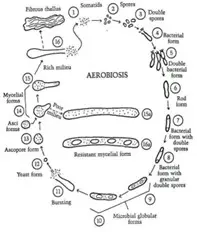Somatids or Microzymas
Somatids: Nature and Function:
Pleomorphic Particles: Somatids are described as elementary, sub-cellular and pleomorphic, meaning they can change forms throughout their life cycle. They are present in all biological fluids, especially blood.
Life Cycle: Somatids are believed to have a complex life cycle that includes multiple stages, with some sources indicating up to 16 distinct forms. The initial stages (somatid, spore, double spore) are found in the blood of healthy individuals.
Regulation of Biological Functions: Somatids are thought to play a crucial role in regulating basic biological functions, such as cellular division and repair. They are considered essential for maintaining life and health.
Connection to Disease: Gaston Naessens theorized that the health of an individual influences whether somatids remain in a benign state or develop into pathogenic forms. This suggests that somatids could be linked with the onset of diseases, including cancer, depending on the internal environment of the host.
Innovative Microscopy: The study of somatids has been facilitated by Gaston Naessens's invention of the somatoscope, which allows for the observation of live biological samples without staining, providing insights into the dynamic nature of these particles.
In summary, somatids are complex,
pleomorphic particles that play significant roles in cellular processes and
health, with their behavior influenced by the overall condition of the host environment
